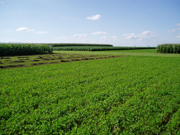American Society of Agronomy
5585 Guilford Road • Madison, WI 53711-5801 • 608-273-8080 • Fax 608-273-2021
www.agronomy.org
Twitter | Facebook
5585 Guilford Road • Madison, WI 53711-5801 • 608-273-8080 • Fax 608-273-2021
www.agronomy.org
Twitter | Facebook
NEWS RELEASE
Contact: Hanna Jeske, Associate Director of Marketing and Brand Strategy, 608-268-3972, hjeske@sciencesocieties.org
Reducing Fossil Energy Use on the Farm
 MADISON, WI, May 3, 2010-Conventional agriculture production relies heavily on fossil fuels, particularly in its ability to provide energy at a low cost. However, the uncertain future of fossil fuel availability and prices point to need to explore energy efficiencies in other cropping systems.
MADISON, WI, May 3, 2010-Conventional agriculture production relies heavily on fossil fuels, particularly in its ability to provide energy at a low cost. However, the uncertain future of fossil fuel availability and prices point to need to explore energy efficiencies in other cropping systems.
Most of the U.S. Corn Belt relies on a two-year rotation of corn and soybean with heavy inputs of fertilizer, herbicides and pesticides derived from fossil fuels to achieve high yields keep costs low. Matt Liebman, Michael Cruse, and their colleagues at Iowa State University conducted a six-year study to compare energy use of a conventionally managed corn and soybean system with two low input cropping systems that use more diverse crops and manure applications, but also use less fertilizer and herbicides. The results were published in the May/June 2010 edition of Agronomy Journal, published by the American Society of Agronomy.
The two input systems consisted of a three-year rotation of corn-soybean/small grain/red clover and a four-year rotation of corn-soybean-small grain/alfalfa-alfalfa. Between 2003 and 2008, nitrogen fertilizer inputs in the 3-year rotation decreased 66% and decreased 78% in the 4-year rotation. Herbicide use decreased 80% in the three-year rotation and 85% in the four-year rotation. Despite the energy input reduction, corn and soybean yields matched or exceeded the conventional system yields.
Did the application of manure decrease the fossil fuel energy costs? Manure prices are dependent on local economic conditions, but the two low-input systems used 23% to 56% less fossil energy than conventional systems. To analyze the energy and economic costs of manure application, the researchers used two approaches. One where manure was a waste product of live stock and essentially free of cost except for the energy used in its application, and a second approach as if the costs of manure were the same as commercial fertilizers. As a low economic input, manure can return $249 per acre, or $28 to $38 under high economic input for four and three-year systems, respectively.
Most of the fossil energy input for all systems was from grain drying and handling. Conditions in northern latitudes, where farmers have limited time to allow grain to dry in the field, make it difficult to reduce this cost. The researchers point out, however, that growing corn less frequently in a rotation sequence can reduce the need for grain drying with fossil energy.
The three and four-year rotation plans rely on agriculture systems where livestock feeding, manure application are integrated into crop production practices. “Iowa has a long history of mixed crop and livestock farming, although these operations do require more management and labor,” said Liebman. “If fossil energy costs rise steeply, we may see more of them again.”
While fossil energy inputs may decrease with manure application and increased crop rotation, the opposite trend is true for labor inputs. A two-year rotation required 41 minutes per acre per year, with a three-year rotation increasing labor 54%, and a four-year rotation requiring 91% more labor. However, the increases in labor were mainly in parts of the year not associated with corn or soybean production activities.
The researchers conclude that low energy prices and high wages contributed to the adoption of the conventional two-year corn/soybean rotation. Fossil fuels offset labor costs and allow net economic returns to remain constant. If demand from ethanol or overseas grain markets increase, or if biofuels from corn stover become economically viable, Midwest cropping systems may continue on a trend of less diversity and more corn. However, if fossil energy prices rise without an increase in crop value, diversified cropping systems may become more preferable.
“It’s hard to predict the exact details of what the future will bring us,” said Liebman. “But results of this study show that we do have options for maintaining high farm productivity and profitability while substantially reducing our dependence on fossil energy.”
The research team was funded by the Leopold Center for Sustainable Agriculture and the U.S. Department of Agriculture. It is expanding its activities into measurements of effects of the different cropping systems on water quality, greenhouse gas emissions, and soil carbon and nitrogen dynamics.
Agronomy Journal is the flagship journal of the American Society of Agronomy. Articles convey original research in agriculture, natural resources, soil science, crop science, agroclimatology, agronomic modeling, production agriculture, and instrumentation.